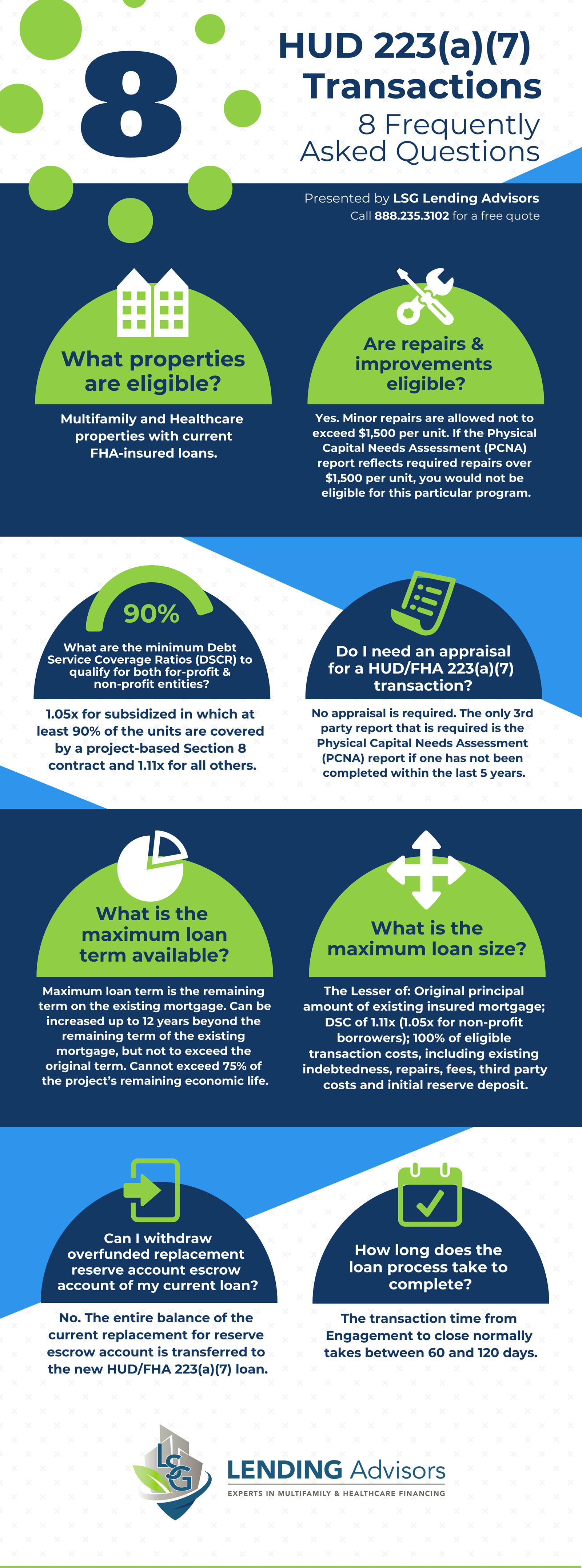The Department of Housing and Urban Development HUD 223(a)(7) program enables owners of healthcare and multifamily properties to refinance. If you’re looking for a trusted method to reduce interest rates and release cash for the improvement of your properties, it’s a great solution.
Here, we answer eight frequently asked questions about HUD 223(a)(7) transactions, to help you determine if it’s the right option for you.
Looking for personalized guidance? Our experienced advisors can help you navigate this complex process – request a free phone consultation today.
What Properties are Eligible for HUD 223(a)(7)?
HUD 223(a)(7) is designed solely as a solution for owners of multifamily and healthcare properties with current FHA-insured loans, that are looking to refinance. These are the only loan types that are eligible.
Your building must currently be insured under Sections 221(d), 223(f), 232, 241, 242, or 220.
To prove your eligibility, you will need the following items:
- Three years of audited balance sheets and operating statements.
- Year-to-date financial statements.
- Trailing 12-month operating statements.
- The last 6 months of rent rolls.
- Three years of occupancy history, by quarter.
- The most recent Physical Needs Assessment (PCNA) report, dated within the last 5 years.
- The latest HUD Real Estate Assessment Center (REAC) score and date issued.
- The most recent mortgage statement and mortgage note.
- A copy of the organizational chart.
- The schedule of real estate owned (REO).
Download our checklist to get ready for your consultation.
Are Repairs and Improvements Eligible?
Yes, you may spend up to $1,500 per unit on minor repairs. However, if repairs of more than $1,500 per unit are required according to the PCNA report, you will not be able to obtain a HUD 223(a)(7). Other factors to note relating to repairs include the following:
- Safety and accessibility repairs are also permitted.
- You must complete critical repairs prior to closing.
- Within 12 months of closing, non-critical repairs must be completed.
Having a clear idea of how many repairs are needed can help you figure out if a HUD 223(a)(7) is right for you.
What are the Minimum Debt Service Coverage Ratios (DSCR) to Qualify for Both For-Profit and Non-Profit Entities?
The minimum debt service coverage ratio required depends on a single factor:
- The minimum DSCR is 1.05x for subsidized projects, in which at least 90% of the units are covered by a project-based Section 8 contract.
- The minimum DSCR is 1.11x for all others.
DSCR is used by lenders to determine whether the loan is viable based on how much the property earns, versus how much is owed.
You can calculate your DSCR by dividing your net operating income by the total debt service.
Do I Need an Appraisal for a HUD/FHA 223(a)(7) Transaction?
You do not need an appraisal to find out if you qualify for this transaction.
There will be only one 3rd party report necessary; the Physical Capital Needs Assessment (PCNA). You will need to obtain one of these if you have not already had one within the last five years.
The HUD is a great resource for learning more about the PCNA.
What is the Maximum Loan Term Available?
The “maximum loan term” refers to the amount of time remaining on the existing mortgage.
- A HUD 223(a)(7) allows you to increase your remaining term by up to 12 years, although you cannot exceed the original term.
- It also cannot exceed 75% of the project’s remaining economic life.
Extending the loan term can significantly reduce your monthly payments, enabling you to invest in the project, additional properties, or other ventures. It can give you the cash you need to update your property, attract new occupants, and drive more revenue for the long term.
What is the Maximum Loan Size?
The maximum loan size you can expect to receive is the lesser value of any of the following:
- The original principal amount of your existing insured mortgage.
- The DSC of 1.11x (and 1.05x for non-profit borrowers).
- 100% of eligible transaction costs, including existing indebtedness, repairs, fees, third-party costs, and initial reserve deposit.
By calculating each of the above, you can get a good idea of how much you may potentially receive ahead of your consultation.
Can I Withdraw from an Overfunded Replacement Reserve Escrow Account Associated with My Current Loan?
No. The entire balance of the current Replacement Reserve escrow account is transferred to the new HUD/FHA 223(a)(7) loan.
The Replacement Reserve is essential for funding major repairs; think of it as an emergency fund, to support you as needed.
How Long Does the Loan Process Take to Complete?
The HUD/FHA 223(a)(7) loan process is very efficient, with transaction time (from engagement to close) taking between 60 and 120 days, on average.
Get started with the process now, and anticipate completion in the next 2-4 months.
Contact Us Today
LSG Lending Advisors is your trusted partner as you explore your options and secure a HUD/FHA 223(a)(7) loan. Refinance your multifamily or healthcare building with expert guidance from our team to ensure you secure the best rates and terms for your unique project. Contact us today to discuss HUD multifamily and healthcare refinancing options, and find the right loan for you.
